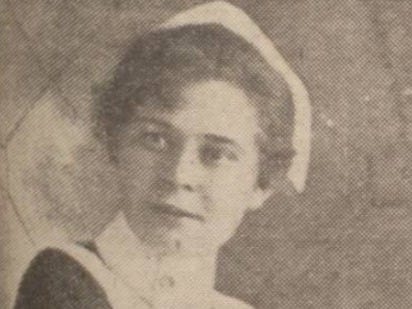Sleepy-eyed commuters at the Middlewood Road tram stop would hardly have even registered the familiar sight of 23-year-old Ada Bradley and 32-year-old Rose Artliff walking down Langsett Avenue on the morning of Wednesday 11th April 1923.
Yet the peaceful start to this ordinary day would not last long. The chimes of a nearby clock striking 5:45am were soon drowned out by Ada’s screams. Within minutes her body lay crumpled on the pavement, whilst Rose, still holding a blood-spattered hammer, looked up at the horrified commuters and exclaimed “that will do.”

The Pauper Lunatics of West Riding
The story starts in Middlewood, around four miles northwest of Sheffield. For over a century the area was dominated by a sprawling institution, built as the South Yorkshire Asylum. It was demolished in 1996 and today the site is home to a pleasant housing estate. However, the legacies of the Victorian asylum still survive: an abandoned church, the lodge house now used as a nursery and the luxury apartments in the converted administration block and the imposing gothic youth asylum.
Luxury, of course, was not associated with the asylum when it first opened in 1871. It was the second asylum to be built in the West Riding region, designed as an overflow institution for the dangerously overcrowded asylum in Wakefield. This new building could accommodate 1,500 people and soon the hospital beds were filled with Yorkshire’s “lunatics” — those who exhibited erratic, unusual and non-conformist behaviour which meant they were considered too dangerous to send to normal hospitals or prisons.
Within years of opening, the number of admissions skyrocketed from 60 patients in 1875 to 381 just two years later. Conditions quickly deteriorated and the already basic sanitary facilities broke down. Public corridors were lined with beds and people were penned into every nook and cranny, whether it had been designed for human habitation or not.

For two years the patients at the asylum had to endure these conditions. By 1879 new wards were constructed, increasing capacity by 700 beds. They stood empty. Somewhat auspiciously, The Wakefield Times noted that cases of lunacy in the district had fallen. In their fervour to limit overcrowding at the asylum, authorities had reduced the amount of people certified as “insane”, highlighting how fickle a nineteenth-century diagnosis was.
Among the causes of insanity listed on patients’ records from 1878 were illnesses we can now identify and treat with modern medicines, such as epilepsy, dementia and post-natal depression. Others were sent to the asylum because of incidents related to loss which had likely led to a breakdown: loss of mother, loss of daughter, loss of business, loss of job, desertion of husband.
Yet some causes of insanity were more elusive: religious mania, poverty, cold, confinement, weakness, hereditary, jealousy of sister, excitement, sunstroke, a love affair. Not all those who were sent to the asylum were confined there for life. Treatments could last for weeks, months or years and the majority were released upon “recovery.”
A Dangerous Woman
Rose Artliff ended up at the asylum in 1920 due to a mixture of bad luck and poverty — generally a dangerous combination in early twentieth century Britain. She had already broken with societal norms by having two illegitimate children. Her marriage to John Henry Artliff in 1916 offered her some security but even this was only fleeting. A few months after the birth of their daughter in 1917, John died and with him went Rose’s chance of a stable life.
As a widow with three young children, she faced an insurmountable battle with destitution and it all came crashing down in April 1920. The rent went unpaid, and eviction loomed. She had sold all her furniture and her three children slept together on the family’s only possession, a hearth rug. One morning she left her children with 1s./6d. (around £3 today), the only money she had, and asked neighbours to look in on them. After closing the door of her Sheffield home, she set off walking towards Nottingham, intent on confronting the father of her two eldest children.
Rose, heavily pregnant with her fourth child at the time, made it as far as Mansfield some 20 miles away. Hungry, dehydrated, and desperate, she threw a brick through a shop window. She did not intend to steal anything, but knew the criminal act would result in a prison sentence. She later told authorities “[I] was so tired I did it to get a rest.”
Whilst Rose served her one-month sentence, her children were sent to a workhouse. Bizarrely, Rose, now homeless, was adamant she would not join her children there, despite the requests of authorities. Even after her newborn daughter was taken from her, Rose still refused to go to the workhouse. Instead, she was sent to the asylum at Middlewood. Her declining mental health may have already been detected and raised concerns, or perhaps the exasperated authorities did not know where else to put her.
At the same time Rose entered the asylum, Ada Bradley started work as a nurse. Ada was born and raised in Wadsley, and she lived on Worrall Road with her parents and siblings, a short walk away from the asylum. When money was tight, Ada’s parents let a spare room out to lodgers.
Somehow in the summer of 1921, Ada managed to persuade her parents to give the room to Rose, her new friend, who was due to be released. Ada probably regaled her parents with Rose’s story and despite everyone’s better judgement and expressions of concern from Ada’s employers, she took Rose home with her.

Surprisingly, everything worked out fine for around 18 months. Every day Rose would accompany Ada on her walk to and from work and she even found employment as a charwoman. But things took a turn for the worst in August 1922 when Rose lost her job, and became solely reliant on the Bradleys’ generosity. Then her world was shattered in January 1923 when Ada became engaged to Walter Cooper, a dashing corporal who had previously been the family’s lodger.
This sparked a fierce jealousy in Rose, who began causing arguments in the household, trying everything in her power to come between Ada and Walter. She accused Walter of having “a certain disease” (likely a venereal disease). She fabricated stories in which she had overheard Walter telling his future bride that she “wasn’t fit to wipe his boots” and that Ada had thrown a kettle at him in response. She tried to ruin the couple’s reputation by falsely stating she had seen them alone in a bedroom together.
Frustrated and exhausted, the Bradleys gave Rose an eviction notice. Everyone assumed that her erratic behaviour was born of jealousy that Walter had chosen Ada over her. In fact, the complete opposite was true. Rose was obsessed with Ada.

Rose would have spent her final week in the Bradley household surrounded by excited chatter about the impending marriage. Ada had been fitted for her wedding dress and Walter’s leave of absence had been approved. Undoubtedly motivated by her past trauma of loss and homelessness, Rose planned to end the situation on her terms and as the clock struck 5:45am on 11th April 1923, she turned towards Ada and struck her repeatedly with a hammer and then slashed her throat.
As her friend lay dying on the pavement, Rose frantically shouted to the onlookers: “I intended to kill her. I intended her to die […] They don’t know it all. They were going to turn me out on Saturday, but they will not have the chance now […] she had done well to live till then, after what I have done to her. She was getting married at Whitsuntide, but that’s off now.” If Rose could not have Ada, then no one could.
Two Lives Lost
Rose was arrested and charged with murder. Among her possessions were: a character reference, two photographs of Ada, and a letter she had written to Ada’s father days before the murder:
I am sorry to bring this trouble to you after you have been so good to me, but I cannot see my way clear to have my revenge any other way on your Ada, Cooper and also your wife… As they are all three against me. You have heard their tales together so it is as I said to you on Saturday morning, when you told me I must leave your house. I knew it was no use complaining against such a set of liars. Your wife said she would make a bad enemy but when she sees this she will know I have made a worse [enemy]. I am writing this letter in the back bedroom on Saturday afternoon Cooper told Ada not to go out with me little does he think she won’t be able to go out with him.

Around 5,000 people attended Ada’s funeral and a month later, in May 1923, the West Riding Assizes Court in Leeds was the scene of Rose’s trial. She was reported to be “quiet and orderly […] but unstable and at times dangerous.” She plucked nervously at her scarf throughout the trial and interrupted the counsel to contest minor points and to accuse Walter Cooper and Mrs Bradley of lying.
Upon hearing her sentence — which declared her guilty but insane, which ultimately spared her the death penalty — she replied: “Thank you very much sir, I was guilty but I was sane.” Rose never again saw freedom and she died in 1973 at Broadmoor, the high-security psychiatric hospital.
Two lives were lost the day that Rose murdered Ada, but Rose’s future had been decided long before she wielded her weapons. She committed a horrific criminal act but it seems obvious that she was also the victim of a system that took a cruel approach to mental health. In my weeks studying newspaper clippings about her from the time, it’s been hard for me to shake the feeling that Rose Artliff was driven to violence by her poverty, insanity and a society that was woefully ill-equipped to help her.
Comments
How to comment:
If you are already a member,
click here to sign in
and leave a comment.
If you aren't a member,
sign up here
to be able to leave a comment.
To add your photo, click here to create a profile on Gravatar.







